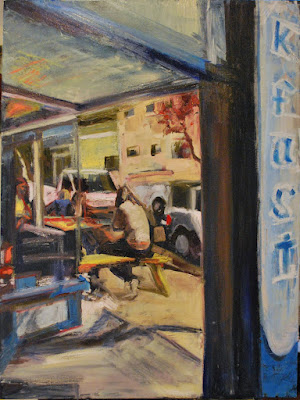

These are oil paintings on canvas, each 12"x16" and each done with the Zorn palette (except on the right, it looks like I may have picked up a little ultramarine blue at the end and put it on the hair and maybe some bits of cadmium yellow, also at the end), painted around 2006. The painting on the left is a self-portrait, done while staring in a mirror (and, no, I don't literally look like that, though I certainly painted what I felt at the time); the painting on the right is my version of a color copy of a work by an artist unknown to me. (This was an exercise from my then teacher, John Paul Thornton.)
The Zorn palette, named after a turn of the century (19th to 20th) Swedish painter, consists of white, ivory black, a yellow and a red (so I was told). I think I used yellow ocher and cadmium red, as my yellow and red on the copy of the unknown painting; I think I used alizarin crimson as my red on the self-portrait.
What you will quickly discover with this palette is that colors are relative. Your black and white mixes will look blue-ish, and your yellow and black mixes will look green-ish. If you take your black and white mix and mix it with your red, you will get something purple-ish, and so on. You can get a lot of beautiful colors from mixing these four colors in varying proportions.
In trying to re-construct when these were painted, I googled this wonderful artist, John Paul Thornton, whom I was lucky enough to learn from when he taught at the now closed Fine Artists Factory in Pasadena. His blog is aptly called Art and Courage; apparently he will have a book, available in June, also called
Art and Courage. If you are interested in learning from a great teacher, I recommend checking it out. If it is anything like his in-person lessons, it will be well worth looking for.








































